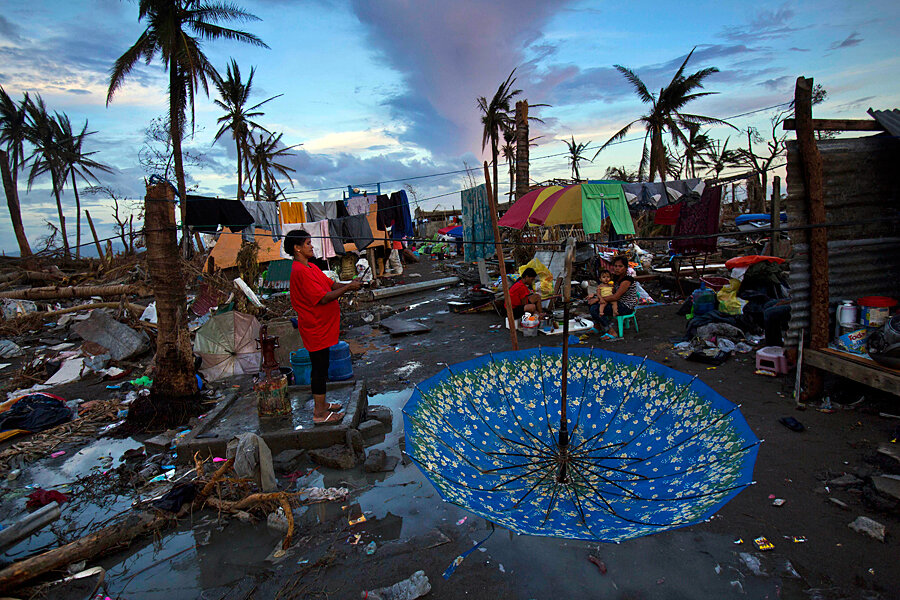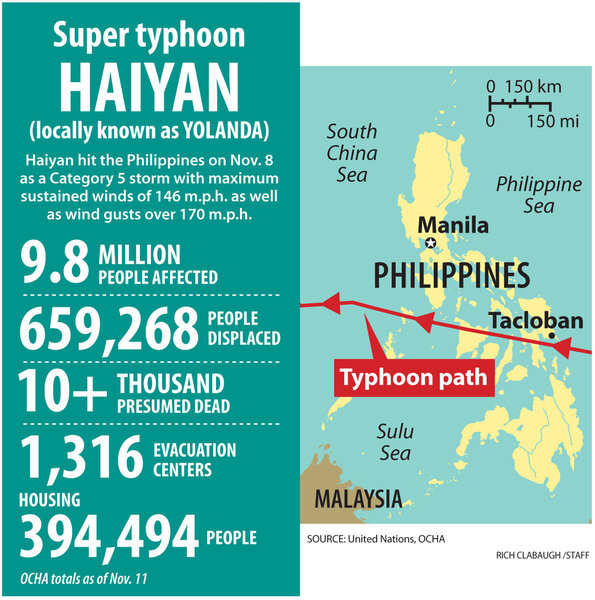Relief effort for Typhoon Haiyan victims gaining traction
Loading...
A roundup of global news reports
A massive international relief operation is underway to help the victims of Typhoon Haiyan in The Philippines, with dozens of countries pledging funds, personnel and supplies to help the affected regions. But aid efforts have been blocked by distribution bottle-necks, leaving many of the 600,000 people displaced by the storm still struggling.
Six days after Haiyan made landfall, supplies, equipment and personnel are trickling in from Manila and the nearby Cebu province to Tacloban on Leyte island and neighboring areas, The Washington Post reported from Cebu on Wednesday morning:
Some aid workers said progress has been too slow. Many who want to help are waiting at airports and air bases, hoping to catch rides from the short-handed Philippine military.
Although more than 30 countries have pledged aid, daunting problems have held up the distribution of goods. Some roads are impassable, and many towns have lost their emergency workers.
Encumbering the relief effort is the fact that near Tacloban there is only one runway open capable of handling cargo flights at the moment. The storm wiped out most of the airport’s modest facilities and equipment, severely limiting access and restricting flights after dark. And in a decision that fueled international criticism, the government allocated many of its military cargo planes to ferrying police and soldiers rather than to bringing aid. The security response was due in part to widespread looting in and around Tacloban.
On Wednesday it appeared that aid was slowly finding ways around the logjam. The US military is installing equipment to enable 24/7 traffic on the runway, the Associated Press reports. Cargo planes are shuttling supplies and medical help onto the island.
At the Tacloban airport, makeshift clinics have been set up and thousands of people were waiting for a flight out. A doctor said supplies of antibiotics and anesthetics arrived Tuesday for the first time.
Curfew imposed by the incoming police forces has restored a semblance of order, and emergency supplies are gradually arriving by air, according to the BBC:
US military planes have been arriving at Tacloban's ruined airport, delivering World Food Programme supplies, which can be carried by helicopter to outlying regions, and a French-Belgian field hospital has been set up.
Meanwhile, a large-scale effort to deliver aid by ship is underway from the US, the UK, Norway and Australia, among other countries. Agence France-Presse reported on Wednesday morning that the US has deployed hundreds of Marines as well as vehicles capable of operating in flooded areas strewn with debris. Capt. Tom Disy, commanding officer of the USS Antietam, one of the US Navy ships en route to The Philippines, told AFP “there will be food, water, medical supplies that meet us in the area, and then we’ll provide the logistics lift required in order to get the supplies from the logistics ship onto the beach.”
The slow pace of the response met widespread international criticism, with local and international observers dismissing the progress achieved to-date as a “pinprick” against the scale of the destruction. But while the shortfalls are staggering, it’s important to keep in mind that the challenges presented by Haiyan may be unmatched by other recent calamities, writes the Associated Press.
In Indonesia's Aceh, the worst-hit region by the 2004 tsunami, relief hubs were easier to set up than in Tacloban. The main airport there was functioning 24-7 within a couple of days of the disaster. While devastation in much of the city of Banda Aceh was total, large inland parts of the city were undamaged, providing a base for aid operations and temporary accommodation for the homeless.
Sara Pantuliano, who heads humanitarian policy at the London-based Overseas Development Institute, told the BBC that the “immense” scale of the crisis would challenge most governments:
The magnitude of the disaster is such that it would test the most seasoned of governments even in the developed world. […] The government did evacuate 750,000 people. So there was a lot that went on before the crisis to prevent the loss of life. Now they are faced with an incredible task, with a logistical nightmare. So many roads are impassable, so many runways are not landable; this is slowing down the aid operation.
I think the international community really needs to resist the urge to be affected by the “savior syndrome” as I call it – to come in and think that they can duplicate these structures, that they can do better, that they can do without the government. Because actually, that would only worsen the response.
The most recent official tally put the number of confirmed deaths at 2,344 on Wednesday morning. Although this figure is expected to rise as the clean-up continues, it remains substantially lower than the 10,000 deaths anticipated earlier this week.








